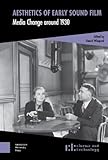Aesthetics of Early Sound Film : Media Change around 1930 / ed. by Daniel Wiegand.
Material type: TextSeries: Cinema and Technology ; 6Publisher: Amsterdam : Amsterdam University Press, [2023]Copyright date: ©2023Description: 1 online resource (308 p.)Content type:
TextSeries: Cinema and Technology ; 6Publisher: Amsterdam : Amsterdam University Press, [2023]Copyright date: ©2023Description: 1 online resource (308 p.)Content type: - 9789048555895
- 791.43 23
- online - DeGruyter
| Item type | Current library | Call number | URL | Status | Notes | Barcode | |
|---|---|---|---|---|---|---|---|
 eBook
eBook
|
Biblioteca "Angelicum" Pont. Univ. S.Tommaso d'Aquino Nuvola online | online - DeGruyter (Browse shelf(Opens below)) | Online access | Not for loan (Accesso limitato) | Accesso per gli utenti autorizzati / Access for authorized users | (dgr)9789048555895 |
Frontmatter -- Table of Contents -- 1. The Aesthetics of Early Sound Film: An Introduction -- Part I: From Silence to Sound -- 2. Dialogue Scenes in the Period of Multiple-Camera Shooting -- 3. Expressive Visual Effects from Silent to Sound Film -- 4. From the Lexigraphic to the Melomanic -- Part II: From Theory to Practice -- 5. “To Select, To Organize, To Sharpen” -- 6. Futurists and ‘Homogenizers’ in Early Soviet Sound Film -- Part III: National Contexts -- 7. Early Japanese Sound Film Aesthetics at Shochiku and Nikkatsu -- 8. Early Sound Films in France: Contexts and Experiments -- 9. Reporters, Radio Waves, and the Dispersed Audience -- Part IV: Speech and Language -- 10. Talking Photographs -- 11. Die Nacht gehört uns/La nuit est à nous and Multilingual Reception in Switzerland -- 12. The Mimetic Attempt of Multiple Versions -- Part V: Music and Noise -- 13. “How Did the Music Get to the Fish Market?” -- 14. The Sounds of War: Reflections on WWI Films of 1930 -- 15. Urban Noise in the Early Italian Sound Film Gli uomini, che mascalzoni … -- General Bibliography -- Index
restricted access online access with authorization star
http://purl.org/coar/access_right/c_16ec
This volume takes a fresh look at the various aesthetics emerging globally in the early sound film era, with a focus on the films’ fundamentally experimental and inventive character. By considering films and production contexts often neglected in film studies, it strives to counter the still dominant view of the transitional period as a time of yet-to-be-perfected forerunners of ‘classical’ sound film. Instead, authors highlight the sense of ‘fruitful uncertainty’ in this period of media change and transformation. Subjects covered include visual and auditory style; the uses of speech, music, and noises; aesthetic conceptions in sound film theory; and intermedial aesthetics. The volume’s scope is decidedly international, covering production and reception contexts in the Soviet Union, Japan, the USA, Germany, France, Italy, the UK, and Switzerland.
Mode of access: Internet via World Wide Web.
In English.
Description based on online resource; title from PDF title page (publisher's Web site, viewed 02. Jun 2024)


